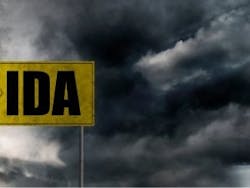How Many Hurricanes Must Slam the Grid Before We Get the Message?
The electric grid’s dysfunctional relationship with hurricanes offers a new twist on the Humpty-Dumpty story. Again and again when fierce storms like Hurricane Ida topple wires and poles, all the king’s horses and all the king’s men do put the grid back together again. But with the next big blow, down it goes.
So it was head-scratching this week to see grid advocates use the storm to pitch more investment in transmission — with little mention of decentralization and microgrids.
No doubt the transmission grid needs to be modernized, but posing it as the way to achieve energy resilience ignores the obvious — the centralized nature of the grid, itself, is the problem. Miles of wires and poles are vulnerable to what appear to be worsening storms. And because of the grid’s interconnectedness, one wire down can cause a cascade of power outages.
“Investment in more transmission alone — and not more microgrids — is far, far from the right answer. It’s like saying if only we had more buggy whips we’d be assured safe travel to the moon,” said Cameron Brooks, executive director of Think Microgrid, an advocacy organization for microgrids.
How much harm did Hurricane Ida cause on the grid? Entergy reported that the storm damaged or destroyed 1,822 transmission structures, 12,453 distribution poles and about 770 miles of distribution line. About 1 million customers lost power and some customers may not see their power restored for weeks.
Trouble overhead and underground
“During these catastrophic events it always comes back to the transmission lines,” said Chris Ellis, executive vice president of manufacturing and product development at PowerSecure, a company that has several microgrids now operating where Hurricane Ida cut its swath of destruction.
Underground wires would help avoid damage from hurricane winds, but the approach comes with some disadvantages. For one, it’s expensive, by some estimates 4 to 10 times the cost of overhead wires. In certain places the price tag is justified, but not all, and grid designers also need to take into account the risk of flooding and the complexity of repairing underground electrical infrastructure.
“It’s more difficult to troubleshoot and repair damaged cable or any type of underground issue,” said Scott Gromer, president and CEO of Mesa Natural Gas Solutions. “It’s just much more expensive to fix.”
Meanwhile, overhead lines are not only vulnerable to the weather, but they also suffer from the effects of line loss — the dissipation of electricity as it travels a distance over wires. The US Department of Energy estimates that about 5% of power generated gets lost en route to the customer. By some private estimates, it’s even greater. Schneider Electric calculates line loss of 8% to 15%.
Line loss, of course, adds to electricity prices. Lux Research recently looked at the cost of delivering power through AC transmission lines as a function of distance and power requirements. Its report, “Decarbonization of Industry: The Future Role of On-Site Power Generation,” found that purchasing power from the grid is widely economical, but this situation starts to reverse at distances beyond about 60 miles when power requirements are below 20 MW.
In addition to looking at the cost of grid power, it’s important to consider the economics of resiliency — how much money businesses save when they are not forced to shut down because of power outages.
“This value proposition is particularly relevant in sectors that demand high degrees of reliability. For instance, data centers are subjected to average downtime costs of $5,600/min. but can face losses as high as $9,000/min.,” said Lux in a summary of the report. “In countries like the US, the need for improved resilience is aggravated by the likelihood of natural phenomena causing outages — which have spurred power grid developments across the country and a rise of backup power solutions.”
Lux advises its clients to consider investing in on-site generation for their own sites and to reconsider the option at least every five years.
The humanitarian argument for microgrids
Reports are coming in from Louisiana that loss of electricity has led to loss of other vital services as well — water, sewage, cellular transmission, gasoline and grocery stores lacking power. It’s a familiar tale told by a string of hurricanes — Katrina, Sandy, Maria, Harvey and many more. Fortunately, microgrids are starting to be built to keep critical services operating in various towns and cities in the US, but clearly not at an adequate pace or scope in Louisiana.
“It is too early to tell what impact Hurricane Ida may have had on specific resiliency hardened systems — large-scale pumping systems and water and wastewater treatment facilities and hospitals come to mind. It is clear that reliance on the grid as a single serving entity for critical systems during a severe storm event has shown to be a weakness,” said Michael Boswell, vice president of power and infrastructure at Concord Engineering. “A properly designed microgrid hardened against storms and with adequate fuel supply for extended operation is a proven solution to maintain delivery of critical services.”
Microgrids are increasingly installed to lower energy costs and increase use of renewable energy. But as PowerSecure’s Ellis noted, right now, in the wake of the suffering from Hurricane Ida, it’s the humanitarian role of microgrids that comes to the fore. PowerSecure has 38 microgrids in the path of Ida that are providing power to a municipal water department, grocery stores, data centers and other crucial operations. The stores are particularly important, he said, because they offer a place for the victims of the hurricane to stock up on food and fill medical prescriptions, not otherwise available. (Check back next week to read Microgrid Knowledge’s upcoming story on the performance of these microgrids.)
“Without the microgrids that are in place right now, and the mobile microgrids that we’ve rolled in, there’d just be a lot of folks that are without basic needs,” Ellis said.
The way to create resilience
“In our experience, resilience is achieved through digitization, redundancy, diversity and proximity,” said Mark Feasel, president of Smart Grid North America for Schneider Electric. “These traits are fundamental to the construction of microgrids and difficult to achieve in other ways. It is clear to me that an approach focused only on transmission and distribution will not achieve the resilience [that is] possible with the incorporation of decentralized solutions.”
By way of example, Feasel described the Schneider microgrid at the Marine Corps Air Station Miramar in San Diego, California — a microgrid that kicked into action last summer when rolling blackouts occurred in the state.
The digitization comes into play, he said, because every generator, feeder and load is monitored. Site operators and control systems have situational awareness and can quickly diagnose the root cause of failures, locate a fault and restore unaffected systems.
The Miramar microgrid functions with a diverse set of energy sources, including solar, natural gas, diesel and landfill gas. The supply chain and storage options of each of these resources is independent, Feasel said.
These multiple energy sources provide redundancy, Feasel said. Further, the electrical distribution system for the base is configured in a ring bus topology with double-ended substations – meaning that electricity can be directed to each load through multiple paths.
Last, the generation is co-located with load. “This inherently reduces exposure of vital grid components to the environment and other forces,” he said.
“Investment in more transmission alone — and not more microgrids — is far, far from the right answer. It’s like saying if only we had more buggy whips we’d be assured safe travel to the moon.” — Cameron Brooks, Think Microgrid
Utilities using microgrids
Tim Allen, chief of commercial development and product strategy at PXiSE, said the key to microgrid resilience “is a reliable mix of internal resources with energy storage paired with the intelligence needed to effectively control and distribute the microgrid’s distributed energy resources at crucial moments.”
When set up properly, a microgrid can operate independently for days to weeks without any connection to an outside power source, he said.
“This means that compromised outside power sources like downed transmission lines, which deliver power from the main grid, would not affect buildings served by a microgrid. Maintaining decentralized energy islands to support essential services and residential systems is critical in times of crisis, and microgrids are a proven option for maintaining power when the larger grid fails,” Allen said.
Scott Kessler, Siemens’ head of microgrid strategy and sales, noted that the microgrid resilience argument is starting to strike a chord with utilities.
“While most people think of microgrids as serving a single organization, we are increasingly seeing utilities — like Commonwealth Edison and their Bronzeville project — show interest in microgrids integrated into their distribution networks.”
With microgrid technology, local generation is less reliant on distant centralized generation, Kessler said. In addition, entire portions of the utility network become hardened to provide resilience to a number of critical community facilities all at once.
“This way, necessary resources such as emergency response, shelter and police can all remain at full operating capacity despite broader outages in the region,” Kessler said.
Beyond the politics
As Erik Svanholm, vice president of non-wires alternatives at S&C Electric said, “When it comes to a question of which section of the grid to invest in to minimize outages after major storms, the answer is not ‘either-or;’ it’s ‘all of the above.'”
“Often the focus of grid improvements is on the transmission system, but the reality is that as long as we are reliant upon centralized power generation, investments need to be made down through the distribution system and to the end of the line,” he said. “Especially as storms become more frequent and devastating, proactive resiliency investments through the grid are critical because when storms inevitably come again, it’s the grid itself that is the first to act, often before line crews are able.”
States are increasingly offering policies or funding designed to bolster microgrid development. Louisiana, however, is not putting the kind of attention into microgrids as states in the Northeast, Mid-Atlantic and West Coast.
Why we must grow the microgrid space
That’s bad news for the 846,840 electric customers in Louisiana that PowerOutage.US said remain without power as of the writing of this article — six days after Hurricane Ida struck.
“This is but [unfortunately] another example of why we must see growth in the microgrid space,” said Michael Bakas, executive vice president at Ameresco, a company that has developed military, government and commercial microgrids.
“While nothing is foolproof, it is fair to suggest that microgrids with local generation sources would have added tremendous resiliency to the system,” Bakas added. “From the articles I read, it appears that New Orleans was counting on one large power plant to feed the entire city should the transmission system fail. One would surmise that this single point of failure is not nearly as resilient as having multiple [smaller] regional microgrids being supplied by local generation resources. Hopefully, we will see state and federal government recognize these ‘lessons learned’ and promulgate incentive/tax credit programs to jump-start microgrid deployment using local, renewable resources such as renewable natural gas, hydrogen, solar, etc.”
Track news about microgrid performance during power outages. Subscribe to the free Microgrid Knowledge Newsletter.
About the Author
Elisa Wood
Editor-in-Chief
Elisa Wood is the editor and founder of EnergyChangemakers.com. She is co-founder and former editor of Microgrid Knowledge.


